Piston ring and its production method
a technology of piston rings and internal combustion engines, which is applied in the direction of manufacturing tools, furnaces, heat treatment apparatus, etc., can solve the problems of poor thermal conductivity of silicon-chromium steel, low-alloy steel, and insufficient nitride, and achieve excellent thermal conductivity, efficient escape to the cylinder wall, and good workability
- Summary
- Abstract
- Description
- Claims
- Application Information
AI Technical Summary
Benefits of technology
Problems solved by technology
Method used
Image
Examples
example 1 (
E1)
[0027]Steel having a composition comprising by mass 0.51% of C, 0.29% of Si, 0.72% of Mn, 0.92% of Cr, and 0.19% of V, the balance being Fe and inevitable impurities, was produced by melting in a 10-kg vacuum induction furnace. The steel was hot-rolled to form a rod having a diameter of 10 mm, and then drawn to form a wire having a rectangular cross section of 2.3 mm in thickness and 1.0 mm in width. Annealing was conducted at 700° C. for 60 minutes during the drawing step. Oil tempering was conducted by oil quenching from heating at 930° C. for 45 seconds to 60° C., and tempering at 470° C. for 60 seconds. The above wire was formed into a compression ring having a nominal diameter of 73 mm, which was subjected to a strain-removing heat treatment at 450° C. for 60 minutes, and provided with an ion-plated CrN coating on the outer peripheral surface, and a gas-nitrided layer on the side and inner peripheral surfaces. The nitriding conditions were 500° C. and 180 minutes. The hardne...
examples 2-4 (
E2-E4), and Comparative Example 1 (C1)
[0032]Each wire was produced in the same manner as in Example 1 except for using steel having the composition shown in Table 1, and formed into a compression ring, which was provided with a CrN coating on the outer peripheral surface, and a nitrided layer on the side and inner peripheral surfaces. The thermal conductivity of each compression ring, and the hardness of each nitrided layer and each base material were measured. The results are shown in Tables 1 to 3 together with those of Example 1.
TABLE 1ThermalCon-Composition (% by mass)*ductivityNo.CSiMnCrMoVBTotalW / (mK)E10.510.290.720.92—0.19—2.6338E20.590.210.691.010.28—2.7835E30.480.190.920.88——0.00052.4739E40.460.240.810.710.220.14—2.5838C10.551.440.680.71———3.3831*P and S were contained as inevitable impurities, though not listed in the table above.
TABLE 2Hardness of Hardness Reduction Nitrided Layer, HV 0.05Ratio HV 0.05 / gm(depth from surface, μm)20-6040-8060-10080-120No.20406080100120μmμmμ...
examples 5 and 6 (
E5 and E6), and Comparative Example 2 (C2)
[0036]Compression rings were produced in the same manner as in Example 1, except for conducting nitriding under the conditions shown in Table 4. As in Example 1, the hardness of each nitrided layer and each base material was measured. The results are shown in Tables 5 and 6.
TABLE 4Nitriding ConditionsTemperatureTimeNo.(° C.)(minute)E5470180E6440300C2510180
TABLE 5Hardness of Hardness Reduction Nitrided Layer, HV 0.05Ratio HV 0.05 / μm(depth from surface, μm)20-40-60-80-204060801001206080100120No.μmμmμmμmμmμmμmμmμmμmE58027456936235334592.73.14.04.1E67737326605995125012.83.33.72.5C28117827627286735641.21.42.24.1
TABLE 6Hardness of Base Material, HV1BeforeAfterRatio(1)No.NitridingNitriding(%)E546943592.8E645543395.2C246541489.0Note:(1)The ratio of hardness after nitriding to hardness before nitriding.
[0037]As is clear from Table 6, when the nitriding temperature exceeded +30° C. over the tempering temperature (Comparative Example 2, C2), the hardne...
PUM
| Property | Measurement | Unit |
|---|---|---|
| temperature | aaaaa | aaaaa |
| temperature | aaaaa | aaaaa |
| temperature | aaaaa | aaaaa |
Abstract
Description
Claims
Application Information
 Login to View More
Login to View More - R&D
- Intellectual Property
- Life Sciences
- Materials
- Tech Scout
- Unparalleled Data Quality
- Higher Quality Content
- 60% Fewer Hallucinations
Browse by: Latest US Patents, China's latest patents, Technical Efficacy Thesaurus, Application Domain, Technology Topic, Popular Technical Reports.
© 2025 PatSnap. All rights reserved.Legal|Privacy policy|Modern Slavery Act Transparency Statement|Sitemap|About US| Contact US: help@patsnap.com

